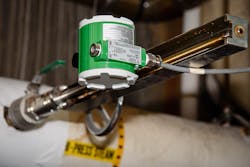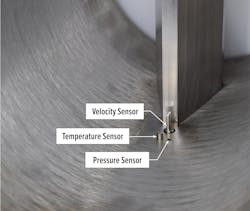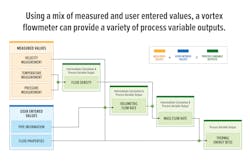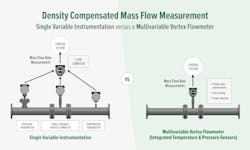Multivariable measurement has been gaining a much wider acceptance over the last decade as end users come to understand the value of capturing additional process variables. As progress continues toward the Fourth Industrial Revolution, the trend in process facilities will continue to be adding more measurement points to collect more relevant data. More relevant data paints a more complete picture of the individual processes and how they interact holistically. For instrument manufacturers, this trend will mean adding more variables to single variable instrumentation. Ultimately, this will lead to multivariable measurement becoming the norm rather than the exception.
What is multivariable measurement?
Upon hearing this term, many think of a multivariable pressure transmitter or a multivariable vortex flowmeter, as they are the most common types of multivariable instrumentation. But taking the word at its literal meaning, a proper definition would be the measurement of more than one independent process variable in a single stand-alone instrument. The list of instrumentation that fits this definition has been and will likely continue to grow.
So, what is the purpose of having multiple sensors in a single instrument? Multivariable measurement fits into two broad use-case categories:
- Multiple measurements
- Compensative measurements
Multiple measurements
This use-case category consists of measurements that are useful as individual stand-alone measurements, but adding them to a single instrument lowers associated installation and maintenance costs. An example would be a multivariable vortex flowmeter, where the operator uses the temperature and pressure measurements as stand-alone measurements.
Compensative measurements
Compensative measurements improve the performance of existing measurements or allow for the calculation of additional measurements that would otherwise be unavailable.
An example of improving performance would be using a temperature sensor to correct for temperature fluctuations that can affect the accuracy of a pressure transducer using strain gauge technology. The operator is not interested in the temperature measurement itself but benefits from the improved accuracy of the pressure measurement.
An example of calculating additional measurements would be adding temperature and static pressure sensors to a differential pressure transmitter. These additional sensors allow for the intermediate calculation of fluid density, which is then used to calculate the mass flow rate of a compressible fluid. Without compensating for the fluid density, an accurate mass flow rate calculation would be impossible.
Multivariable instrument types
Modern multivariable instruments can produce a variety of process variables, covering the more conventional process variables such as flow, pressure, temperature and level, as well as less conventional process variables such as density, viscosity and liquid conductivity. Many of these less conventional process variables are used in intermediate calculations, so the operator may not even be aware of their availability. But, depending on the process, they may also prove valuable as stand-alone process variables.
The first multivariable instruments were multivariable pressure transmitters developed in the early 1990s. In addition to being the first, these transmitters are perhaps the most versatile type of multivariable instrumentation. Adding temperature and differential pressure sensors gives this technology the ability to calculate fluid density and mass rate in flow metering applications. This same ability to calculate fluid density proves valuable in tank level measurement applications as well.
Vortex flowmeters are another commonly used multivariable instrument. Similar to the multivariable pressure transmitter, adding temperature and pressure measurements gives these flowmeters the ability to calculate fluid density and mass flow rate. Combining the ability to measure mass flow rate and the vortex flowmeter's inherently rugged design make it one of the best options for mass flow rate metering of saturated steam.
Coriolis flowmeters measure mass flow directly as their primary measurement. As such, most people view Coriolis flowmeters solely as high-accuracy mass flow measurement devices. But, many Coriolis flowmeters can also provide fluid temperature, density and viscosity measurements. Similarly, electromagnetic flowmeters are generally thought of as high-accuracy volumetric flow measurement devices, but many can also provide liquid conductivity and temperature measurements.
Capturing the supplemental data
The additional process variables that multivariable instruments supply can provide valuable insight into a process. However, these variables are not of any value unless they make it back to the control room, which begs the question, what is the best method to capture all of these additional data points?
In this age of the Internet of Things (IoT), there are abundant methods to capture this data. But the method chosen will likely hinge on two factors — the facility's overarching communication strategy and whether the additional data is for monitoring or control. Monitoring is the process of collecting process data without using it as part of an active control loop. Process variables used for monitoring purposes generally have less stringent requirements for availability and speed. More critical process variables used in active control loops must meet minimum requirements for availability and speed.
Analog signals (4-20 mA) still dominate most process facilities. Many multivariable instruments offer dedicated analog outputs for each variable measured. This method is a popular choice, but it certainly has its downsides. If you add up the number of multivariable instruments and the number of variables on those instruments, it becomes apparent rather quickly that this method could require an extreme amount of wiring — as many wires as variables. Excessive wiring also means taking up valuable I/O space in the control room.
HART (Highway Addressable Remote Transducer) protocol is an open standard used to send and receive digital information using analog wiring between devices and control systems. HART signals share the pair of wires used by analog signals. In effect, additional data is transferred without additional wiring. This fact alone makes HART an excellent choice for capturing supplemental process variables. HART has also been adopted widely across process facilities. So, it is a familiar technology, and many existing I/O cards can capture this HART data. However, HART does have limitations. The speed of HART communications is relatively low. Therefore, some operators prefer only to use HART data for monitoring purposes.
Perhaps the best solution for capturing this additional data is digital fieldbus protocols. Many different fieldbus protocols are available; some are open, and some are proprietary to a specific vendor. But, they all allow for a large amount of data transfer at a rapid rate. Also, all of the data rides on the same physical layer. So, multiple process variables communicate over the same wiring, which is a significant advantage over analog signals.
A newer option is wireless data transmission using WirelessHART. Data is sent wirelessly from the instrument to a receiver or gateway. From the gateway, this data can be hard-wired to the control system using a digital fieldbus protocol. This option is a particularly great solution for retrofitting existing multivariable instruments that speak HART. A WirelessHART adapter can be added to the existing instrument instead of replacing older I/O cards that do not communicate HART. In this way, WirelessHART communication does not interfere with the instrument's wired connection to the control system.
Applications best suited for multivariable measurement
While most process facilities will have ample opportunities to utilize multivariable measurements, there are undoubtedly specific applications where these measurements shine.
Compressible fluids such as gases and steam quite often experience changes in their density. Volumetric flowmeters cannot account for these changes and will produce an inaccurate flow measurement.
Therefore, density compensated mass flow metering is a better method of flow metering for compressible fluids. Temperature and pressure measurements are used to calculate fluid density. This fluid density is then used in combination with volumetric flow rate to calculate a mass flow rate. Both multivariable vortex and differential pressure flowmeters utilize this method of mass flow metering. Having these sensors in a single instrument reduces the number of pipe penetrations, the amount of wiring and the number of devices.
Thermal energy metering, or BTU metering, is the measurement of energy in hydronic or steam-based heating and cooling systems. Thermal energy metering requires multiple measurements in the form of volumetric flow rate and fluid temperature. Calculations are performed with these measurements to produce a thermal energy measurement.
Advantages and disadvantages of multivariable measurement
Like any technology, multivariable instruments have their own merits and limitations. Ultimately, the intended application will significantly influence whether the technology is advantageous over single-variable measurement.
Key advantages of multivariable measurement include:
- Lower installation and maintenance costs versus multiple single-variable instruments.
- Lower upfront cost versus buying multiple single-variable instruments.
- Fewer number of pipe penetrations and potential leak points versus multiple single-variable instruments.
- Fewer number of electrical connections and less cabling versus multiple single-variable instruments.
- Fewer number of overall devices in the field.
- Can correct for potential sources of error, such as changes in fluid density.
- Can provide compensative measurements, such as mass flow rate.
- More process variables can lead to more insight into a process.
Key disadvantages of multivariable measurement include:
- Higher upfront cost versus a comparable single-variable instrument.
- Additional data is of no use unless there is a viable way of bringing it back to the control system.
- Embedded sensors could be challenging to replace if there is a failure.
Conclusion
Multivariable measurement will continue to grow in use as the benefits outweigh the drawbacks for an increasing number of applications. The additional process variables that multivariable instruments supply can provide valuable insight into a process. However, capturing this additional data will challenge facilities to create new communications strategies or adjust their existing strategy accordingly. Facilities that successfully adapt will undoubtedly reap the many rewards offered by multivariable measurement.
Ryan Bennett is a product marketing manager for VorTek Instruments in Longmont, Colorado. He holds a B.S. in industrial distribution from the University of Alabama at Birmingham. Bennett has had a strong focus on flow metering throughout his career. He has worked in various roles at VorTek Instruments, with a current focus on new product development and marketing. He can be reached at [email protected].
About the Author

Ryan Bennett
Product marketing manager
Ryan Bennett is a product marketing manager for VorTek Instruments in Longmont, Colorado. He holds a B.S. in industrial distribution from the University of Alabama at Birmingham. Bennett has had a strong focus on steam metering, control and distribution throughout his career. He has worked in various roles at VorTek Instruments, with a current focus on new product development and marketing. Bennett can be reached at [email protected].




